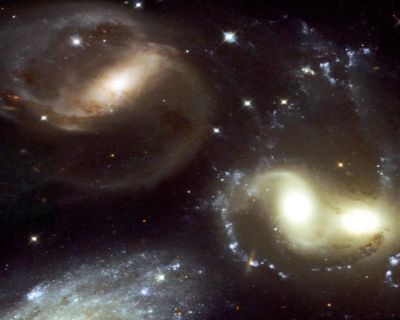When is a galactic grouping ‘compact’? Take a look at the four closely grouped galaxies in the image below; they’re most of the galaxies in Stephan’s Quintet (the fifth is off-image to the lower right). Redshift measurements indicate that the top three of these are at the same distance from us, about 300 million light years away in Pegasus. A group is considered compact when it shares the same gas reservoir, or so I learned while reading about a presentation on the subject made by C. Mendes de Olivera at the ongoing IAU meeting in Prague.

Image: Four of the galaxies of Stephan’s Quintet. The galaxy at bottom left is a foreground object, but the other three are at the same distance from us and engaged in spectacular gravitational interactions. Credit: Jane C. Charlton (Penn State) et al., HST, ESA, NASA.
I owe the opportunity to learn about these matters to Ph.D student Thomas Marquart, who is working in the Galaxy Group at Uppsala Astronomical Observatory in Sweden. Marquart is posting regular entries on the IAU’s General Assembly on a weblog and is inviting (though with little result so far) other participants in the meeting to post their own thoughts as the sessions continue. In any case, his own observations, largely focusing on galactic evolution, make for lively reading and offer a sense of participation in a major scientific event.
One that, it must be said, has more to do than focus on the status of Pluto, despite newspaper stories implying that the subject has conference goers on the edge of their seats. Better by far to read about the IAU’s work at a site like this, and let’s hope that weblogs, which are easy to set up, become a regular part of such scientific gatherings. Sure, they’re unofficial, and that’s their interest. They give you inside thoughts rather than press releases, with comments on the hot issues and insights into the personalities involved.
And yes, as to Pluto, my thinking remains the same. Whatever the IAU decides is fine by me, though if it were my decision, I would leave Pluto with a planetary designation and simply declare its size the lower limit for planets. There are good reasons for acknowledging its properties as a Kuiper Belt object, but it’s also true that we have much to learn about the Kuiper Belt and what it contains. The safer course, keeping us from changing our nomenclature every few decades, would be to defer any change of planetary status until we’ve had a closer look at Pluto and other Kuiper Belt objects, starting with New Horizons in 2015. More on this tomorrow and then on to more pressing things.


I have to say his attitude towards the public and media reaction
to the designation of Pluto and all similar objects has a strong
feeling of intergalactic snobbery from the old days of astronomy
(mainly pre-Space Age).
You know: The further it is from the Sol system (meaning Percival
Lowell and his ancient Martians with their darn canals), the more
important it is – to the professional astronomers.
Instead of this elitist attitude, I hope astronomers will use this
opportunity to educate the public and media on our favorite science
while at least one aspect of the field is hot, trendy, and generating publicity. Otherwise, where do they hope to get future astronomers
from, to say nothing of public support at tax time?
As for naming Pluto and all the smaller worlds, what about the good
old term Planetoid?
It means “little planets”, is less awkward than dwarf planets, and
goes in line with the less accurate term asteroid (little star).
I also think black holes should be called collapsars, keeping in line
with pulsars and quasars.
Hi Paul & Larry
SpaceDaily reports the draft definition will be that a planet is any independently orbitting mass that forms a spheroid in gravitational equilibrium.
Oddly enough Pluto & Charon are both candidates – either a typo or acknowledgement they’re a true double-planet -i.e. their mutual centre-of-gravity is in free space between them.
I like the suggested term ‘pluton’ for the ice dwarf worlds past Neptune, but here’s one thing that’s annoying me. UB313 is not in the Kuiper Belt, technically, since its inclination and semi-major axis are so high. So why shouldn’t it be an independent planet even if Pluto is just a KBO?
As I read this, though, plutons are simply designated as such by their distance, eccentricity and inclination, which would leave UB313 a pluton even if not technically in the Kuiper Belt. So maybe we need a different term for non-Belt objects of high eccentricity and inclination? :-) This could get even more confusing, and probably will as we learn more about the real boundaries of the Kuiper Belt. Fascinating times, though I’m glad I’m not charged with comng up with names for all the new objects we’ll be uncovering!
Stephan’s Quintet
Credit: NASA, ESA, and the Hubble SM4 ERO Team
Explanation: The first identified compact galaxy group, Stephan’s Quintet is featured in this stunning image from the newly upgraded Hubble Space Telescope. About 300 million light-years away, only four galaxies of the group are actually locked in a cosmic dance of repeated close encounters. The odd man out is easy to spot, though.
The four interacting galaxies (NGC 7319, 7318A, 7318B, and 7317) have an overall yellowish cast and tend to have distorted loops and tails, grown under the influence of disruptive gravitational tides. But the bluish galaxy at the upper left (NGC 7320) is much closer than the others. A mere 40 million light-years distant, it isn’t part of the interacting group.
In fact, individual stars in the foreground galaxy can be seen in the sharp Hubble image, hinting that it is much closer than the others. Stephan’s Quintet lies within the boundaries of the high flying constellation Pegasus.
http://antwrp.gsfc.nasa.gov/apod/ap090911.html